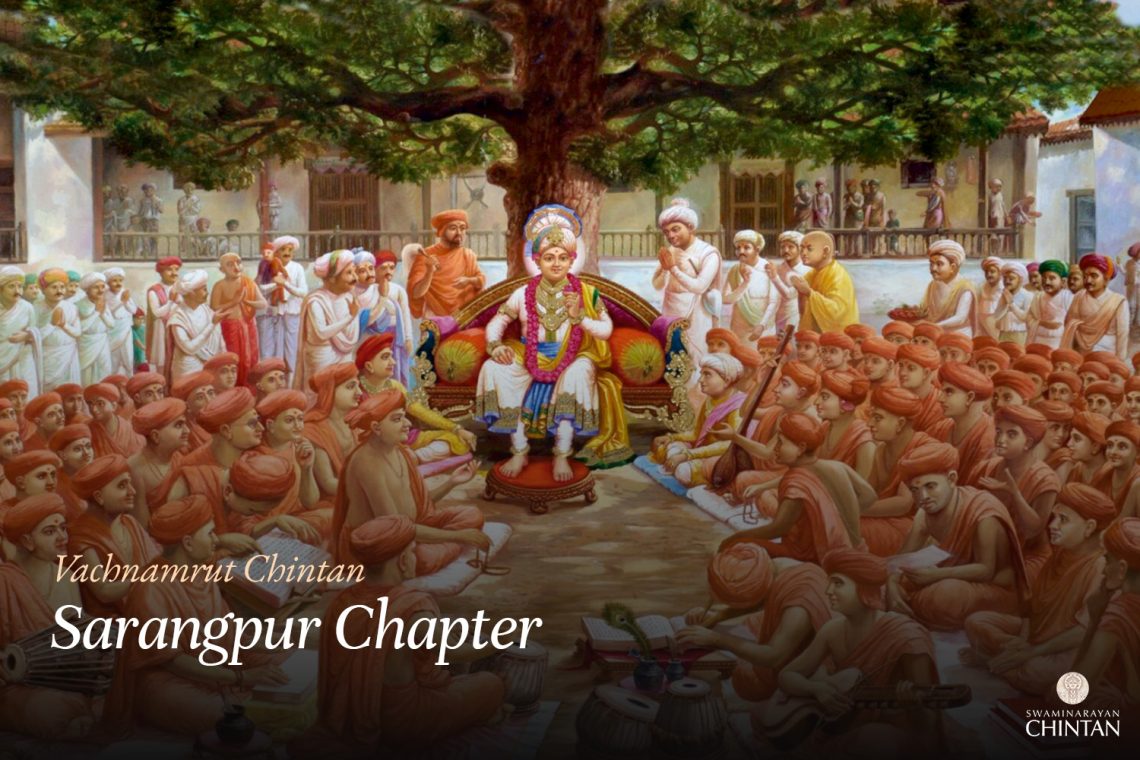Central Insights:
- The differences among the Muktas (liberated souls).
Main Points:
- The primary reason for the difference in the state of Mukta (liberation) is the extent and intensity of one’s connection with Bhagwan.
- The reason for deficiency in the state of Mukta is the depth of one’s connection with Maya (illusion) and Mayik (material) emotions.
Commentary:
This Vachanamrut focuses on the differences among the Muktas (liberated souls). Maharaj explains why not all devotees of Bhagwan who are liberated appear to be at the same level. Why are there different stages among them? To clarify this, Maharaj explains that as the perspective of the devotee becomes more refined, he begins to understand the true greatness of Paramatma (Supreme God) more and more. When the soul identifies itself with the body, it perceives Paramatma as being beyond the three states of consciousness (Jagrat, Swapna, and Sushupti). When the soul perceives itself as beyond these three states, it realizes that Bhagwan is even beyond that, and His greatness becomes more apparent. As the devotee’s focus increasingly concentrates on Bhagwan, his Upasana (worship) becomes stronger and stronger. As a result, the servant-master relationship between the devotee and Bhagwan deepens, and the level of Mukta also increases.
Maharaj first gives the example of creatures from ants to large crocodiles. An ant, a frog, a human, a horse, an elephant, and large crocodiles all drink water from the ocean and gain strength. However, they drink according to their own capacity. Similarly, what can one consume from Paramatma, who is like the ocean? Many things, such as the association with devotees, the auspicious qualities of Bhagwan, noble sentiments, the principles of Bhagwan, and the constant remembrance of His Murti (divine form), are available to be absorbed from Bhagwan. The outcome of this absorption is increased strength to walk the path of Bhagwan. As one absorbs Dharma (moral integrity), Gnan (knowledge), Vairagya (detachment), Bhakti (devotion), Tyag (renunciation), and Seva (service), the level of Mukta increases accordingly.
The second example Maharaj gives is that of the sky and the birds that fly within it. Here, Maharaj represents the sky, and the birds—mosquitoes, sparrows, falcons, hawks, the mythical Anal bird, and eagles—represent different devotees. Understanding the greatness of Bhagwan is akin to flying, and realizing one’s own smallness and attaching oneself to Bhagwan with the attitude of a servant is the result. expanded in Satsangijeevan, Chapter 6, Verse 1.) In the teachings of Sadguru Gopalanand Swami, in various discourses (e.g., Prakaran 2, Verses 6, 19, 37, 39; and Prakaran 3, Verses 32, 33), the differences among devotees and Muktas are explained in detail. Similarly, in the teachings of Sadguru Gunatitanand Swami, in various discourses (e.g., Prakaran 1, Verses 48, 157; Prakaran 2, Verse 68; Prakaran 3,Verses 65, 87, 120; and Prakaran 5, Verse 138), the types of devotees and Muktas are shown.
The third example is that of light or brilliance (Tej). In this, darkness represents Maya and Mayik emotions. The glow of a firefly, the light of a lamp, the flame of a torch, the blaze of a fire, a wildfire, lightning, the moon, the fire of dissolution, and Mahatej (supreme light) all represent different levels of light. The removal of Maya or Mayik emotions is the result. (This analogy is further
The fundamental reason for the difference in the state of Mukta lies in the intensity and nature of one’s connection with Bhagwan. Any deficiency in the state of Mukta is due to how deeply one is entrenched in Maya and Mayik emotions. Often, devotees feel that attempting to apply this Vachanamrut or the teachings of Swami in their lives might lead to more harm than good. Questions arise such as: Which devotees are of a higher level? Which are of a lower level? What is our real status? Attempting to answer these questions might create confusion and conflict. This is because, even though they are devotees, they are not willing to acknowledge or accept their true shortcomings. They readily accept or even fabricate a false sense of superiority. Therefore, studying the lives of living devotees and applying their teachings involves considerable risk. Nonetheless, Maharaj and the great saints have demonstrated that there are different levels among devotees for a reason. In today’s spiritual context, doubts naturally arise. But what Maharaj has written is meant to guide those seeking liberation (Mumukshu), not to highlight the weaknesses of others. Though it may be a reality, that is not the primary intent. As long as the Mumukshu understands where they stand on the spiritual path, and who is ahead or behind them, their progress will be quicker, and the risk of error will be minimized. This has been pointed out with good intentions, and devotees should reflect on this with the same positive mindset.
Glossary
| Mukta – Liberated soul A soul that has transcended Maya and attained eternal service of Bhagwan. |
| Paramatma – Supreme God God, the all-pervading and ultimate reality. |
| Upasana – Worship and devotion The practice of deep meditation and attachment to Bhagwan. |
| Maya – Illusion The material energy that entangles the Jeev in worldly existence and distracts from Bhagwan. |
| Mayik Emotions – Material feelings Desires and emotions that arise due to attachment to the material world. |
| Dharma – Righteousness |
| Gyan – Spiritual knowledge |
| Vairagya – Detachment From Everything Except God |
| Bhakti – Devotion Loving and selfless worship of God. |
| Tyag – Renunciation |
| Seva – Selfless service |
| Three States of Consciousness – Jagrat, Swapna, Sushupti |
| Mumukshu – Seeker of liberation (Moksh) |

